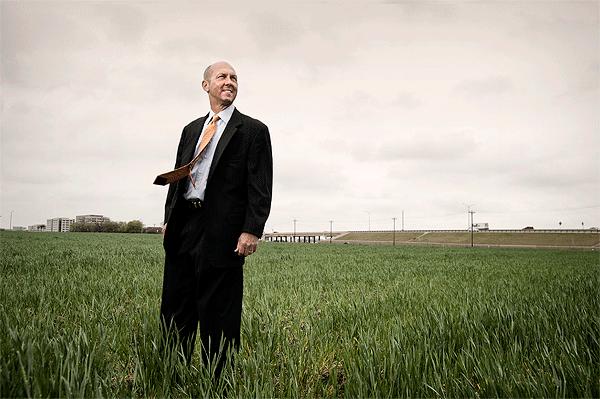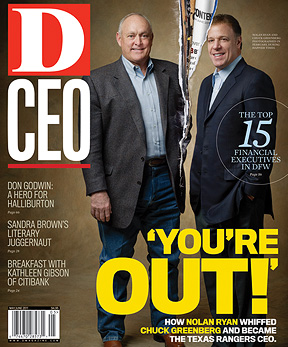Gerald O’Hara has a memorable line in Gone With the Wind: “Land is the only thing in the world worth workin’ for, worth fightin’ for, worth dyin’ for, because it’s the only thing that lasts.”
North Texas commercial real estate firms seem to be embracing a love for land, as they prepare for what experts say is a coming wave of property deals. Among them is Jones Lang LaSalle, which recently hired former Lincoln Property Co. executive Tom McElroy to launch a land division within the firm.
“Here we are in 2011, and Dallas has 6 million people,” says Paul Whitman, who leads JLL’s local operations as regional president. “We’re going to grow to 9 million by 2025, a 14-year period. A lot of land is going to change hands as a result of that.”
Jones Lang LaSalle is one of the world’s largest commercial real estate firms. The new land group is a local initiative, formed at Whitman’s urging due to trends that are unique to Dallas. Beyond the population growth is the market’s sheer geographic size and volume of undeveloped land, as well as projected demand from investors, developers, and end users—including existing JLL clients.
“There are tremendous synergies with the services we’re already providing,” McElroy says. “I’ve chosen an office near the tenant rep brokers for a reason.”
Two other developing market forces are also driving demand: the growing number of REOs and land investment funds.
Along with residential and commercial properties whose loans have gone bad, lenders are taking possession of land parcels through foreclosures. These non-performing assets are classified by lenders as REOs (real estate owned properties). Although land seems to be an uncomplicated class of real estate—what’s more basic than raw land?—the opposite is true.
To effectively value and market the property, owners must determine its highest and best use and consider myriad variables that will affect its development, everything from planning and zoning issues to access to water and other utilities. Most banks don’t want to hassle with these things, so they’ll turn to outside land experts to help get the properties off their books.
At the same time, land investment funds are multiplying and growing. “They think the time is right to get to the right multiples,” McElroy says. “That means recovering 2 to 2.5 times their investment in a three-year period. For land acquisitions, that would be difficult [to achieve] at top-of-market.”
One of the region’s most successful land investment companies is Dallas-based Stratford Land. The firm is more than halfway toward its goal of raising $750 million through its Land Fund IV, which it launched last year. Investors include pension funds and other instutional players, endowments, high-net-worth individuals, and firm principals.
When it comes to acquisitions, Stratford targets tracts in high-growth areas. It currently owns about 40,000 acres, primarily in Texas and other Sunbelt states. It achieves strong average returns—historically, 20 percent—by adding value through planning, securing entitlements, and other pre-development work. Its typical hold is three to seven years.
The JLL team led by McElroy also will perform pre-development services.
So, if the number of sellers and buyers are both growing, why aren’t more deals already getting done? It all comes down to price: Banks are holding out for values set in better times.
“They’re having to take back land and they’re not wanting to get rid of it at the discount buyers are saying they’ve got to have,” McElroy says. “Until they accept a discount to what the borrower owed, we’re not going to see any movement.”
The breakthrough will come within the next 12 months, he says. “The pressure is going to mount, and when it does, you’ll see a lot of investors buying bank-owned properties. There’s a flood of money sitting on the sidelines.”
Dichotomous Market
Deals are getting done on the residential side, says Ted Wilson, principal at Residential Strategies Inc. “It’s already happening,” he says.
After home sales tanked in the last quarter of 2008 and first quarter of 2009, home starts correspondingly fell. That led to “the great washout,” Wilson says, where more that half of the area’s production builders closed or left the area. “We went from having more than 70 builders to about 30,” he says. “It was ugly. And because of that, a lot of land positions became available.”
The well-located lots were quickly gobbled up. D.R. Horton, First Texas Homes, and Grand Homes were the first homebuilders to go after them; others followed suit. By the end of 2009, most of the A lots were pretty much gone.
“In 2010, we saw the entitled lot positions—those that are teed up and ready to go—get bought by the public builders and regional privates that were strong,” Wilson says. “Now in 2011, we’re at a point where there are not many lot positions out there in good markets. High-growth A markets are getting back to equilibrium—about a 24-month supply of lots. So you’ve got this dichotomous situation; the A markets are very tight, but in the C markets, there’s a big excess of supply.”
Tougher mortgage qualification standards have put the chill on demand for entry-level homes. Builders in that space can’t get the velocity in sales they need to warrant additional land buys.
Developers—those who ready raw tracts for builders—have also taken a hit. At one point there were 80 to 100 independent developers in North Texas, Wilson says. That has been whittled down to about 15. “The onesy-twosy-deal guys are gone,” he says.
Well capitalized developers—like Hillwood, Republic Property Group, Hines, and Centurion American—are scouring the market for their next big plays, and land funds are revving up. The hot spots all point north, “from North Fort Worth diagonally across DFW,” Wilson says. “Markets like Flower Mound and Coppell, Irving, Carrllton, Frisco, Allen, and McKinney. Values in those areas have not suffered.”
About half of Craig Ranch’s 2,200 acres in McKinney have been developed. Much of the land that remains available is slated for commercial use. Twelve acres were recently snapped up by Traxxas, which has tapped Dallas-based KDC to build a new corporate headquarters on the site. Initial plans called for a 125,000-square-foot campus; Traxxas has sinced upped that to 250,000 square feet in three buildings, says David Craig, who owns the sprawling mixed-use community.
Craig says he has an advantage when developers are looking for parcels, not just because of the project’s prime location along the new Sam Rayburn S.H. 121 Tollway, but also because Craig Ranch has infrastructure and amenities in place.
“There is not a lot of raw, speculative land out in the marketplace, unless someone has gotten in trouble, which, of course, creates opportunities,” he says. “I’m blessed to have a very strong capital partner, so we have continued to grow. We’re attracting corporate projects and the residential sales are strong. Home sales at Craig Ranch were up 74 percent in 2010 compared to 2009, and I can tell you that the first quarter of 2011 will far exceed what we had in 2010.”
‘Prices will spike overnight’
One of the area’s foremost authorities on land is Ray Utley, who oversees about a dozen brokers in the land and ranch division at Henry S. Miller. He got into the business 30 years ago, after seven years of coaching football at Southern Methodist University.
Utley has brokered a number of high-profile deals, including the sale of Ross Perot’s exotic ranch in Jacksboro and Boone Pickens’ ranch in Pampa, but his bread and butter is residential and commercial tracts in North Texas.
“As one of our brokers puts it, 2011 is a ‘feel-good’ year,” Utley says. “Starting in October of 2010, you could sense that everyone was getting ready to make a move.” It may be a while—18 to 24 months—before the market works through the flood of REO properties, he says. “But when it breaks, we will have a tremendous run. Prices will spike overnight.”
It’s critical that land gets back in the hands of private developers, to spark economic growth. Until then, the non-performing REOs will continue to be a drag. It’s another reason that now is a good time for investors to buy, Utley says.
“They’re waiting, but they’re making a mistake,” he says. If a piece of property is a good investment, they need to go ahead and make the move. The market is depressed, so they’re now in a position to pick and choose. If it’s going to be a good real estate deal in the future, they should go ahead and buy it now.”
The land guru cautions, however, against unrealistic expectations. People should plan on a five- to seven-year hold; they can hope for a three-year turn, but are “foolish” to expect it, he says. “If someone calls me and wants to double their money in two years, I tell them I keep all those deals for myself,” he jokes. “I’m making the point that they’re being unrealistic.”
Patience, however, can certainly be rewarded. The Perots, for example, have done pretty well.
In the early 1980s, Ross Perot Sr. bought 2,700 acres in Plano and began developing Legacy business park. About 50,000 people now live and work there; corporate tenants include JCPenney, Frito-Lay Co., Dr Pepper Snapple Group, Pepsico, and Ericsson.
Similarly, Ross Perot Jr. developed the 17,000-acre AllianceTexas in North Fort Worth. It’s now home to more than 250 companies, 78,000 employees, and 7,400 single-family homes, and generated an economic impact of about $2 billion in 2009.
“At the end of the day, big money is going to be made here in land,” Utley says. “History has proven that.”
For daily reports on Dallas commercial real estate news, visit realpoints.dmagazine.com.






